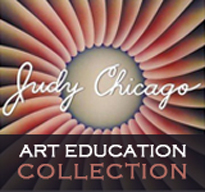Forum Replies Created
-
AuthorPosts
-
jennlake
ParticipantI feel that an effective way to achieve this open and responsive environment for students is for teachers to begin in the same manner that Chicago’s pedagogy is presented. Having the ability to create and expose learners to a new atmosphere where they have control over what and how they learn is essential. In order to move away from positioning the teacher as an authority figure, one must allow the student means for self-discovery in a way that gives them the power to make decisions. I can recall from my own experiences within an art classroom that it takes time to have the confidence to take direction in your own work. Many times, I would look to my instructor to give me solutions, and to lead me in a certain way. I was under the impression that an instructor should have all the answers, and for that matter, all the right answers. With practice and guidance techniques, a good instructor can lead a student who seeks this help to other methods of discovery, experimentation, and reflection. Dialogue and discussion with peers is an effective way to do this, and I believe it can be the first step in engaging students to reflect and innovate new ways of personal engagement within their work. I am reminded of our first class session in A ED 322, where each of us became engrossed in conversation with another classmate with the purposes of brainstorming and developing the exploration of our concept or idea. This was exceptionally helpful for me, as I could use my classmate’s thoughts and ideas as a resource to facilitate my thinking. Having a multitude of differing perspectives on my concept was influential to my own self-discovery with the topic, as it gave me a certain confidence in knowing that I could have a conversation about my ideas with others in a way that helped to progress my knowledge and thinking. I think that this methodology can be translated in a way that teachers could use one on one with a student, or within an entire classroom. Giving students the opportunity to verbalize and have an open-ended discovery of their ideas will allow them to take control over the research and decision making of their thoughts and ideas. I feel that this method of facilitation lends well to the aspect of creative thinking and innovation, which is a concept I am currently exploring. Practicing this method of active guidance and facilitation for students will allow them to develop thinking strategies required for discernment, and also to strengthen their sense of agency to determine for themselves how they might tackle a certain problem. It is important to create a classroom environment where as a facilitator you are not pointing students in a set direction towards the answer. Educators should facilitate art as an investigation, and in the words of Olivia Gude, we need to help students “understand the art of others and seeing their own art making, not as exercises, but as research that produces new visual and conceptual insights.”
-
AuthorPosts
